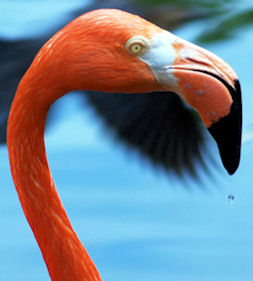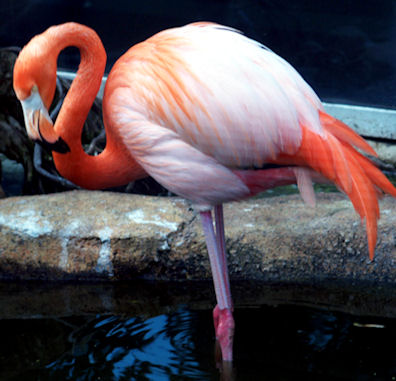Pink Flamingos
Today, pink flamingos. The University of Houston's College of Engineering presents this series about the machines that make our civilization run, and the people whose ingenuity created them.
Art seems to ride a bifurcating evolutionary path. On the one hand, all high art seems to bubble up out of the grass-roots our society. Jazz, once a folk art, is now a huge influence in classical music; so is the tango. Brahms, Vaughn-Williams, Bartok, were all inspired by folk songs. Millet and van Gough struggled to anchor their art in the texture of life among the poor.
But then think about Courier-Ives prints and Norman Rockwell. The art they gave us was so terribly vulnerable to reduction. We’re surrounded by warm and fuzzy rip-offs of their work. The glow of the Christmas fire is so elemental that we cheapen it every chance we get. Dűrer’s Praying Hands, so anatomically perfect, so expressive of human need, have been made laughably trite.
We engineers like to describe instability with the image of a marble rolling along a sharp ridge. It’ll quickly fall off one side or the other. Any new art rides that same ridge. Rob art of its dark side, let it say nothing of the dangers within the human dilemma, and it rolls off into the abyss of kitsch.
 I was set off on this riff by an article about pink flamingos. What delicate beauty and shading of color those creatures provide. A young designer -- a classically trained sculptor -- named Don Featherstone, working for a company called United Products, used National Geographic images to create the famous (now infamous) lawn decoration. He captured the beauty of the bird rather well -- and the rest, as we say, is history.
I was set off on this riff by an article about pink flamingos. What delicate beauty and shading of color those creatures provide. A young designer -- a classically trained sculptor -- named Don Featherstone, working for a company called United Products, used National Geographic images to create the famous (now infamous) lawn decoration. He captured the beauty of the bird rather well -- and the rest, as we say, is history.
But when is history simple? Pink Flamingos flourished for a while. Featherstone went on to become president of the company while those pretty pink birds festooned the trailer courts of America. Of course America reacted in revulsion. Sears dropped the pink bird from its catalog in 1970. Two years later John Waters made the movie Pink Flamingos and included every perversion he could think of. He left the pink flamingo forever linked to our churning stomachs. Movie critic Roger Ebert said of the movie, “I am not giving [it] a star rating ... because stars simply seem not to apply. It should be considered not as a film but as a fact, or perhaps as an object.”
As I write, another Christmas is upon us. Restaurants and malls assail us with soulless singers making a mockery of the season’s once-noble hymns -- the pink flamingos of the musical world.
So I ponder the upward and downward movements of art. Featherstone was handed one of the infamous Ig Nobel Prizes for his birds. But now his company recently quit making them. We’re about to see their value skyrocket, as rarity turns them back into art.
Last year, we went on a bird watch and saw a lost flamingo who’d made his home with a flock of pelicans in the Texas Inland Waterway. A sad sight -- that lovely lonely bird, seeking acceptance among others who saw only an alien. The distressing irony of seeing that poor bird reduced as far in life as he had been in art.

I’m John Lienhard from the University of Houston, where we’re interested in the way inventive minds work.
(Theme music)
S. Silverman, Lindbergh's Artificial Heart. (Kansas City: Andrews McNeel Publishing, 2003): pp. 33-35.
(All photos by JHL)
